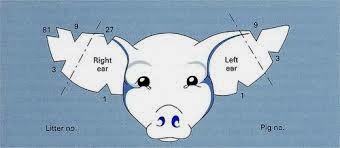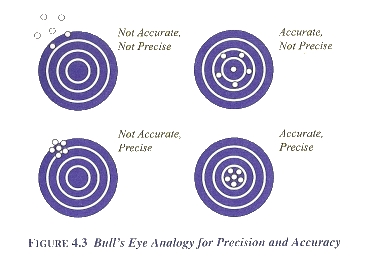- Your first homework set is not graded yet. I'll have it for you next time.
- A comment on the Clear command....
- Clear[x]
- Clear["Global`*"]
Is a good command to put at the top of a file (although someone might get mad if you slip that in on them and they have expended a lot of energy getting some results, which will get lost!:)
- If you're working interactively, you can quit the kernel from the Evaluation menu.
- Questions on anything? Current homework?
Section 2.1:
"The main idea is that the computer works with a finite subset of the reals known as machine numbers." (p. 33)
- Section 2.1: Positional Number Systems
I might have started this chapter with Figure 2.3, on page 41:

It gives a picture of machine numbers on a "toy binary computer". Section 2.1 makes a point about the need to consider other bases (other than 10). Among these other bases, the base 2 is probably the most important.
Question: why does base 2 figure so prominently in computer science?
There's a beautiful example here of how base 3 is used for tagging hogs (poor hogs!):


Questions:
- I didn't like the first images alone, so I grabbed the second image above off the -- what didn't I like about the first image?
- What is the identifier for the first pig?
- What other bases do you use? Why?
- Would you know how to convert from a one base to another?
- Suppose, for example, that you want to convert from 10 to 2; how do you do that?
- Then, how do you convert from 2 to 10?
Let's try a few. What's
-
in base 2?
-
in base 10?
- One more, with a twist:
in base 8?
Our author makes the point that numbers may terminate in one base, yet repeat in another. $5.2_{10}$ in base 2, for example.
Questions:
- What are the consequences, therefore, if we store the
number $5.2_{10}$ in a machine built on binary (base 2) architecture?
- Can you think of an example of a number that repeats in base 10, but doesn't in base 3?
- Section 2.2: Floating-Point Numbers
In this section the authors describe the manner in which numbers are stored in the computer. They focus on "floating-point numbers", which are represented by three parts:
- The sign of the number
- The position of the "radix" point (aka decimal point in base 10) -- we might say the "order of magnitude" of the base.
- The mantissa (the known digits)
+2.99792458E08 (m/s) Question: Does that number look familiar?Definition 2.1: A real number is said to be an n-digit number if it can be expressed as
Question: They then ask "What's an n-bit number?" (p. 39) What do you tell them?
Let's imagine that our machine has base-10 architecture, with
, and
. Then we know exactly which numbers may be represented: numbers from
Largest magnitude numbers -9.999x109 +9.999x109 Smallest magnitude numbers -1.000x10-9 +1.000x10-9 ) is non-zero (except for 0 itself). This gives us exactly the same number of digits at each order of magnitude of 10.
Failure to include the denormalized numbers (that don't have a leading 1) leads to a gap around zero in this figure:

On the downside, if we allowed non-zero leading digits, then there would be redundant representations for many numbers (e.g. +1.000x10-9=+0.100x10-8)
Questions:
- See if you can make sense of the markings on the graphic above:
, and
- What happens if we restrict a machine so that it has architecture
?
Now, in reality, computations are usually done in base 2, and the IEEE standard for single precision and double precision are
Single Double Base 2 2 n 24 53 e [-126:127] [-1022:1023] Question: in each case, how many exponents are there in the exponent range? Of what significance is that number?
Question: let's see if we can make sense of this system with this particular example:

Our authors describe the difference between precision and accuracy at this point: I think that it's best done graphically:
- Section 2.3: Rounding
"The purpose of rounding in computation is to turn any real number into a machine number, preferably the nearest one." (p. 43)
But there are different ways to do it. You're no doubt familiar with rounding (but how do you handle ties -- that is, how do we round 19.5 to an integer?)). The authors suggest several strategies (p. 43):
- Rule 1: "round-to-even": if the digits following the nth digit are
- less than 500000....
then discard these digits - greater than 500000....
then discard these digits and add 1 to the nth digit - exactly equal to 500000....
then discard these digits and add 1 to the nth digit if it is odd.
"Round-to-even" because if nth digit is even, do nothing; add 1 if odd, making it even. All nth digits become even.
- less than 500000....
- Rule 2: "round-to-nearest, with round away from zero in case of a tie"
Same as Rule 1, except when exactly equal to 500000....
then round UP (away from zero).Inferior to Rule 1, as ever-so-slightly biased away from zero.
- Rule 3: chopping -- "round-to-zero" -- truncation.
Whatever comes after nth, just drop it.
Inferior to Rule 1, as slightly biased toward zero.
The biases are illustrated nicely in Figure 2.5, p. 45:

The chopping approximations are all under-estimates; the rounding methods give more balanced overs and unders; but the rounding alone has a bias for giving overestimates, which rounding-to-even balances out.
There is some vocabulary here with which we should be familiar: sometimes rounding results in
- overflow (
)
- underflow (below the smallest possible machine number)
- NaN (not a number)
Definitions:
- fl (float)
- converts real numbers into machine numbers
- A real number is said to be representable if
- it rounds to a machine number (neither overflow nor
underflow, nor NaN).
- relative representation error:
-
The authors make the case that
where
-
is the base, and
-
is the precision (number of decimals in the mantissa)
- #3, p. 48
- #7, p. 49
- Rule 1: "round-to-even": if the digits following the nth digit are
- Section 2.4: Basic Operations
By "basic operations" the authors mean using standard arithmetic operations on machine numbers to produce machine numbers. There will be errors.
Let a and b be machine numbers, and let
represent any of the standard arithmetic operations. Then
I.e., to compute one of these binary operations with machine numbers, you do the operation exactly, and then convert it to a machine number with float (fl). We already know what this will cost: we'll have a roundoff error of
.
As we compute more complicated function, however, with one unary or binary operation after another, the errors continue to accumulate (as seen for example, in section 2.4.5, p. 54).
Examples:
- #1, p. 54: Assuming four digit floating-point arithmetic with
round-to-even rounding, perform the following computations:
(a) 0.6668+0.3334 (b) 1000.-0.05001 (c) 2.000*0.6667 (d) 25.00/16.00 - #8, p. 55
- #9, p. 56
- #1, p. 54: Assuming four digit floating-point arithmetic with
round-to-even rounding, perform the following computations:
- Section 2.5: Numerical Instability
This section features several interesting examples of functions, some of them tremendously important, which are also extraordinarily sensitive to errors.
One of the main points of the section is that a "solution" to a problem may be technically correct, analytically correct, and yet poorly designed to produce good results in general.
An excellent example is the quadratic formula. Many of you have memorized it as
We can imagine situations, however, for which this calculation may be dangerous. What do you notice?
Question: an old trick from your past may be used to improve things: can you think of how to change this formula, to make it less sensitive?